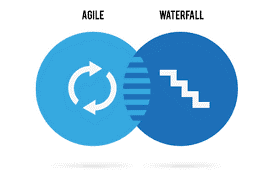
The Project Management Institute (PMI) is making a bold pivot toward agile. As a project manager and an agilist, I am excited by these moves. At the same time, it is hard to envision both this transition and the future state.
In this article, I share some of my thoughts about the upcoming changes to the Project Management Professional (PMP®) exam and PMBOK® Guide.
What Changed
Two years ago, PMI took modest steps toward integrating agile into the fold. The PMBOK 6th Edition included brief sections on agile practices and considerations. As a companion, PMI published the Agile Practice Guide®, which was a more detailed but still a modest foray into the realm.
In June, PMI announced a significant realignment of the PMP exam. The exam questions will be split between agile and predictive methodologies; and the question domains will shift from the existing 5-project management process groups to: People, Process, and Business Environment. Initially, PMI planned to roll out these changes on December 16, 2019, but just pushed back the date to July 1, 2020.
In August, PMI acquired Scott Ambler’s Disciplined Agile company. With this move, PMI intends to strengthen the profession by “adding strong, credible new capabilities and certifications that will differentiate project managers and open doors.”
PMI also launched the process for creating the next edition of the PMBOK, which will most likely be published in 2-years. I expect this 7th Edition will represent a significant rewrite and restructuring of the standard. Presumably, the Guide will cover multiple methodologies (waterfall, hybrid, iterative, and adaptive) and reflect the changes in the exam structure.
Toward a Unified Theory of Project Management?
Albert Einstein spent the last 20-years of his life searching for the Unified Theory of Physics, the key that would align his theory of relativity with electromagnetism. Many of his peers thought that he wasted his brilliance on this unfulfilled pursuit.
I have a hard time imaging a unified theory of project management. It is a vast profession. Software and technology projects are inherently different from those that bring new drugs to market or construct a building or bridge. They all have unique time horizons, risk profiles, and tolerance for change.
NASA recently completed the Voyager mission to Saturn—it was a 41-year project! The program manager spent nearly her entire career working on this singular effort. In contrast, I have overseen thousands of projects in my much shorter career.
Once I met a commander in the British Royal Air Force who was responsible for the avionics on the Harrier fighter jets. I was in awe of his responsibilities. If he made a mistake, a $30 million plane and a pilot could be lost. My projects were inconsequential by comparison.
The diversity of the industries and environments in which we work makes project management an engaging profession. It also makes it challenging to generalize practices and develop even a “few sizes fit all” framework.
Teams of knowledge workers benefit from the collaborative and empowered environments promoted by agile. These practices unlock creative energy and potential. Experimentation and adaption often lead to unexpected yet better outcomes.
On a construction project, there is little to be gained from tapping the imagination of the laborers. Adherence to the architecture and engineering design specifications along with compliance to safety standards is preferred. Following a well-defined plan is required.
It will be interesting to see how the needs of various project types, industries, and environments are addressed as PMI and the industry adapt to these changing times.
Focus on Best Practices
If a unified framework of project management exists, it will undoubtedly be very complicated. However, there are considerable opportunities to share best practice across the spectrum of projects types.
I am experienced and comfortable using both traditional and agile project management frameworks. Each has its strengths and weaknesses in a given context. I find that mixing practices from multiple disciplines lead to better outcomes than following just a single path.
I use the agile practices of team chartering, product road mapping, Kanban boards, and stand-up meetings when working in traditional and non-project environments. The rigor of a thoughtful stakeholder analysis, usually associated with predictive projects, is fundamental to the success of any undertaking.
A challenge to updating the body of knowledge will be integrating process-based explicit knowledge with the fuzzy logic of tacit understanding. It is relatively easy to document and codify explicit knowledge. However, sharing the nuance of wisdom and experience is much harder.
The Cart Before the Horse
I feel that changing the PMP exam 2-years before the next PMBOK update may be putting the cart before the horse. The PMBOK serves as a primary reference and clearly communicates what PM’s are expected to know before taking the exam. Until PMI provides additional guidance and information, there will be uncertainty about the new exam which will create anxiety.
As we approach the exam change, I hope to see more and more regular communication about what to expect. Creating greater clarity about the new exam should ease the transition and reduce anxiety about the future state. Providing more information will benefit the entire project management community and improve perceptions of the upcoming changes.
It Has to Be Easier Than This
The PMBOK Guide is over 700 pages long, and the Agile Practice Guide is another 150 pages. By contrast, the Scrum Guide is only 19 pages!
While the PMBOK is a certified ANSI standard, it is not readily accessible or understandable by the average project manager. Only after I became an instructor, did I appreciate the wisdom contained in the Guide.
As a profession, we need to develop a set of values, standards, and operating practices that can be easily read, comprehended, and referenced by project managers. In other words, we need to simplify the process drastically.
I wish my colleagues who will be working on the next edition of the PMBOK Guide the best of luck. They will dedicate countless hours over the next two years developing this important industry standard. It will not be an easy task.
I thank them for their contribution to our profession.
© 2019, Alan Zucker; Project Management Essentials, LLC
To learn more about our training and consulting services, or to subscribe to our Newsletter, visit our website: www.pmessentials.us.
Related Project Management Essentials articles:
- Knowledge Management: Share the Wisdom
- Learning to Love the PMBOK®–It Wasn’t Easy
- Road Trippin’ Organizational Change: The Beginning
- Scrum vs. Kanban: What to Choose
Image courtesy of vslive.com

